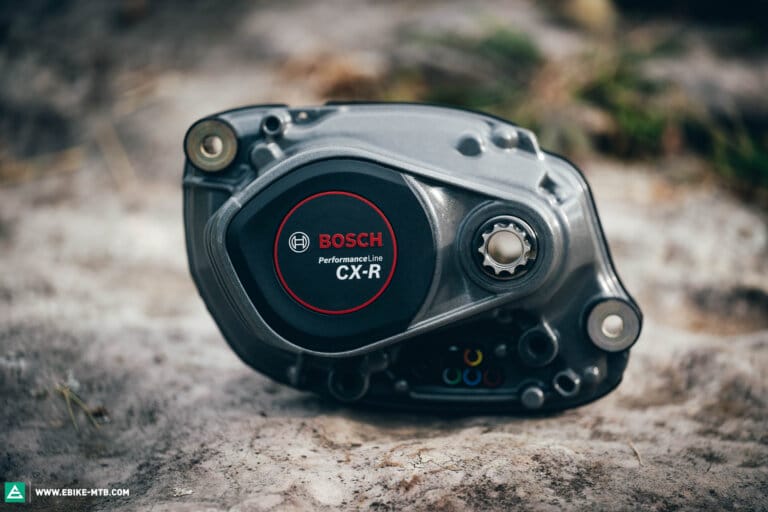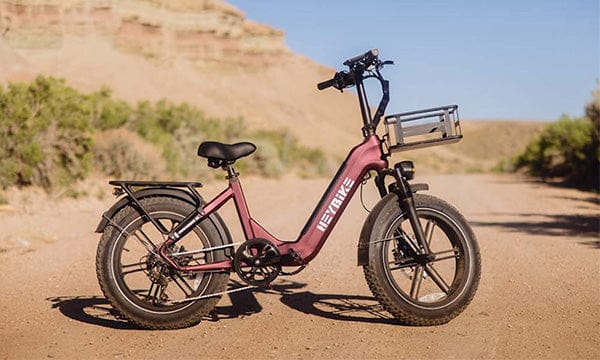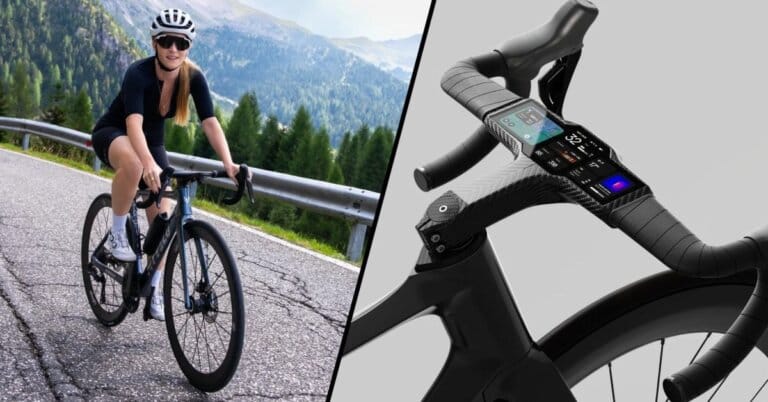The Best E-Mountain Bike of 2025? Rocky Mountain Instinct Powerplay SL Carbon 70 on Test
This bike is part of our big group test: The Best E-Mountainbike of 2025 – Featuring the 30 Most Exciting E-MTBs of the Year. Click here for the full intro, key takeaways, and all the bikes we tested.

20.3 kg in size L | € 9,700 | Manufacturer’s website
Since 1981, Rocky Mountain have been building bikes with true Canadian spirit – designed for tough terrain and serious riding. In 2017, the brand took its first step into the eMTB world, partnering closely with Dyname, a Canadian motor manufacturer that has exclusively powered Rocky Mountain’s e-bikes ever since. Now, with the Instinct Powerplay SL, Dyname are introducing a brand-new motor: the Dyname S4 Lite Mid-Power system, which delivers 65 Nm of torque and 550 W peak power.
With 150/145 mm of front travel, 20.3 kg system weight, and a price tag of €9,700, the big question is: Can the Rocky Mountain Instinct Powerplay SL Carbon 70 hold its own against the fierce competition despite the low-assistance motor? And does the concept of this unique drive system actually work?



What Sets the Rocky Mountain Instinct Powerplay SL Carbon 70 Apart From the Competition?
At first glance, the Rocky Mountain Instinct Powerplay SL necessarily look like a light eMTB. While at 252 mm circumference, the downtube is the second slimmest in this test, the motor area looks rather bulky – and at just over 20 kg, the scales confirm that impression. The 480 Wh battery in the downtube can be removed for charging, but the process is a bit fiddly. First, you’ll have to unbolt the motor cover, and then remove two more screws that hold in place the battery. Only then can you slide out the battery past the motor – and we recommend flipping the bike upside down todo this. The battery can be charged both externally and directly on the bike via the port on the left above the motor, which is protected by a solid rubber cap.

The Dyname S4 Lite motor delivers 65 Nm of torque and 550 W peak power. Instead of driving the chainring directly, it transfers power via an additional small cog onto the chain. This gives Rocky Mountain’s engineers more freedom with rear suspension designs but also results in a noticeably rough, grinding feel through the drivetrain.

The big Jumbotron display keeps things simple with a black-and-white readout showing the current ride mode, speed, battery charge status, and cadence. Adjusting ride modes requires navigating an unintuitive menu directly on the bike – because there’s no companion app. That makes the Rocky Mountain the only bike in this test without smartphone connectivity, which could be a dealbreaker for tech-nerds. The remote sits on the left side of the handlebars, and features well-defined buttons that make it easy to switch between ride modes.


The downtube can hold either a bottle or a 314 Wh range extender. A generously sized, soft-rubber chainstay protector prevents chain slap, while the bolted cable ports eliminate rattling noises – nice!
Rocky Mountain opted for a practical, well-thought-out spec rather than chasing prestige with useless bling. The FOX suspension consists of a 36 Performance Elite GRIP X fork and a matching FOX Float X Performance Elite shock, generating 150/ 145 mm of travel, respectively. The GRIP X damper performs almost as well as the GRIP X2 but produces a rather odd slurping noise. High- and low-speed compression can be adjusted externally, while rebound has a single setting.
Shifting is taken care of by an electronic SRAM GX Eagle Transmission drivetrain, which relies on a direct-mount rear derailleur, and delivers precise, butter-smooth gear shifts. SRAM Code Silver Stealth brakes do stopping duties, providing powerful, reliable deceleration in combination with 200 mm rotors front and rear. The neatly-routed brake hoses ensure a clean cockpit.

The FOX Transfer Performance Elite dropper post has 180 mm of travel, ensuring sufficient freedom of movement and reliable operation. The Race Face ARC 30 aluminium wheelset is paired MAXXIS tires, with a DHF at the front and a DHR II at the rear, both in the EXO+ casing and MaxxTerra rubber compound. For better traction, we recommend upgrading the front tire to a model with the softer MaxxGrip rubber compound and, while you’re at it, the rear tire to a tougher variant with the robust DoubleDown casing.

Rocky Mountain Instinct Powerplay SL Carbon 70
€ 9,700
Specifications
Motor Dyname S4 Lite 65 Nm
Battery Powerplay Akku 480 Wh
Display Jumbotron
Fork FOX 36 Performance Elite GRIP X 150 mm
Rear Shock FOX Float X Performance Elite 145 mm
Seatpost FOX Transfer Performance Elite 180 mm
Brakes SRAM CODE Silver Stealth 200/200 mm
Drivetrain SRAM GX Eagle AXS Transmission 1×12
Stem Rocky Mountain 35 40 mm
Handlebar Race Face Turbine 780 mm
Wheelset Race Face ARC 30 29″
Tires MAXXIS Minion DHF, MaxxTerra, EXO+ / MAXXIS Minion DHR II, MaxxTerra, EXO+ 2.5″/2.4″
Technical Data
Size XS S M L XL
Weight 20.3 kg
Trailer approval no
Kickstand mount no
Specific Features
flip-chip
Tuning Tip: Upgrade to a front tire with softer MaxxGrip compound and a rear tire with the tougher DoubleDown casing when the first tire change is due.
| Size | SM | MD | LG | XL |
|---|---|---|---|---|
| Seat Tube | 365 mm | 410 mm | 440 mm | 470 mm |
| Top Tube | 566 mm | 598 mm | 626 mm | 658 mm |
| Head Tube | 105 mm | 110 mm | 125 mm | 135 mm |
| Head Angle | 64° | 64° | 64° | 64° |
| Seat Angle | 77.5° | 77° | 77° | 77° |
| Chainstay | 436 mm | 436 mm | 447 mm | 447 mm |
| BB Drop | 17 mm | 17 mm | 17.1 mm | 17.1 mm |
| Wheelbase | 1199 mm | 1226 mm | 1268 mm | 1309 mm |
| Reach | 430 mm | 455 mm | 480 mm | 510 mm |
| Stack | 614 mm | 618 mm | 632 mm | 641 mm |

How Did the Rocky Mountain Instinct Powerplay SL Carbon 70 fare in our test?
The Dyname motor of the Rocky Mountain Instinct Powerplay SL feels noticeably different from the more “conventional” e-bike motors. While it has a strong response and delivers its power in a similar way as the Bosch SX, it lacks the extra kick the Bosch provides at higher cadences. The unique aspect of the Dyname motor is that you never exceed a maximum cadence threshold – the 65 Nm of support remains consistent across nearly the entire RPM range, even at extremely high cadences. This results in a smooth, predictable pedalling feel, though it lacks a distinctive power surge.
Riders who embrace this linear power delivery and are willing to put in some extra effort, will be able to negotiate even steep climbs with confidence. In technical uphills, the Rocky Mountain can hold its own against the Orbea Rise, which relies on a full-power Shimano motor. The front wheel remains planted on the ground in steep sections, but on fire road climbs, you’ll have to endure slightly more pressure on your wrists. In terms of efficiency, the Powerplay SL Carbon 70 even competes with full-power bikes like the KTM Macina and Propain Shresh, making the most of every watt-hour. We managed to squeeze 1,411 vertical metres out of the 480 Wh battery – though naturally, this came at the cost of average speed and significantly reduced motor power below 10% battery charge.
The spec of the Rocky Mountain Instinct Powerplay SL Carbon 70 prioritises function over prestige – aside from the tire choice, there’s little to criticise.

Riding downhill, the Instinct Powerplay is intuitive to ride, though the lower front end makes it feel slightly more front-heavy than you might be used to. This translates to great traction on dry trails but can become a limiting factor in wet conditions – switching to a softer rubber compound would be a worthwhile upgrade. Once you adjust to the low front end, the bike naturally encourages a more aggressive riding position. And that’s where the Rocky Mountain really comes to life, carrying speed through open corners with ease, while at the same time delivering plenty of feedback from the ground. As a result, it’s reassuringly composed but also incredibly playful. Flow trails are an absolute blast on the Instinct Powerplay SL Carbon 70 – the firm suspension makes it easy to pump through rollers and berms, allowing you to generate plenty of speed.
Grip through open corners and an aggressive riding position – the low front end of the Instinct Powerplay SL Carbon 70 keeps plenty of weight on the front wheel.

On technical trails, the Rocky Mountain always remains composed and makes you feel as if you had more than 150 mm of travel on tap. The suspension eagerly absorbs roots and rocks, though lifting the front wheel over obstacles requires slightly more physical effort. In rough, blocked terrain, it requires an active riding style, whereby the relatively low system weight and intuitive handling help a little. Instead of simply ploughing through, it lets you navigate tight turns with precision and agility. That said, when it comes to pure downhill capability, bikes like the Santa Cruz Vala and YT Decoy SN are even more composed, thus inspiring more confidence in rough technical sections.



Who Should Take a Closer Look at the Rocky Mountain Instinct Powerplay SL Carbon 70?
The Rocky Mountain Instinct Powerplay SL Carbon 70 is an e-bike for eccentrics – riders who deliberately stray from the mainstream. The Dyname motor is anything but off-the-shelf, and delivers a unique ride feel that is somewhere between a powerful light-assist system and a full-power drive. Those willing to pedal a bit harder will be rewarded with excellent climbing performance, making even steep climbs feel controlled and manageable. If you’re after a distinctive, characterful bike with a linear power delivery, the Instinct Powerplay SL Carbon 70 is a well-executed, capable eMTB – best suited for experienced riders and those who value individuality.

Conclusions about the Rocky Mountain Instinct Powerplay SL Carbon 70
The Rocky Mountain Instinct Powerplay SL Carbon 70 hits the sweet spot between support and endurance for sporty e-mountain bikers. It’s neither incredibly light nor overly powerful, and instead finds its place right in between. Despite its “modest” performance on paper, it climbs surprisingly well thanks to the linear motor characteristics. Riding downhill, the strong suspension is particularly impressive, though the low front end is better suited for skilled riders. This is an e-bike that appeals more to MTB riders than traditional e-bikers.
Tops
- Intuitive handling
- Front wheel always remains planted to the ground, both uphill and downhill
- Motor delivers strong, steady support
Flops
- Front end is hard to lift
- Battery removal is not very intuitive
- No app or connectivity features
More info via bikes.com
The test field
For an overview of the test field head to our “Best E-Mountainbike of 2025” comparison test – 30 of the most exciting trail bikes in our 2025 group test
All bikes in test: AMFLOW PL Carbon Pro, Canyon Spectral:ONfly CF LTD, FOCUS JAM² 6.0, GHOST E-RIOT LTD, Haibike HYBE CF 11, MERIDA eONE-SIXTY SL 10K, Orbea WILD M-LTD, Orbea Rise LT M-Team, R RAYMON Tarok Ultra, Rocky Mountain Instinct Powerplay SL, Santa Cruz Vala X0 AXS RSV, SCOTT Patron ST 900 Tuned, Specialized S-Works Turbo Levo 4, Transition Regulator CX XT, UNNO Mith Pro, YT DECOY SN MX CORE 3.

Words & Photos: Julian Schwede







